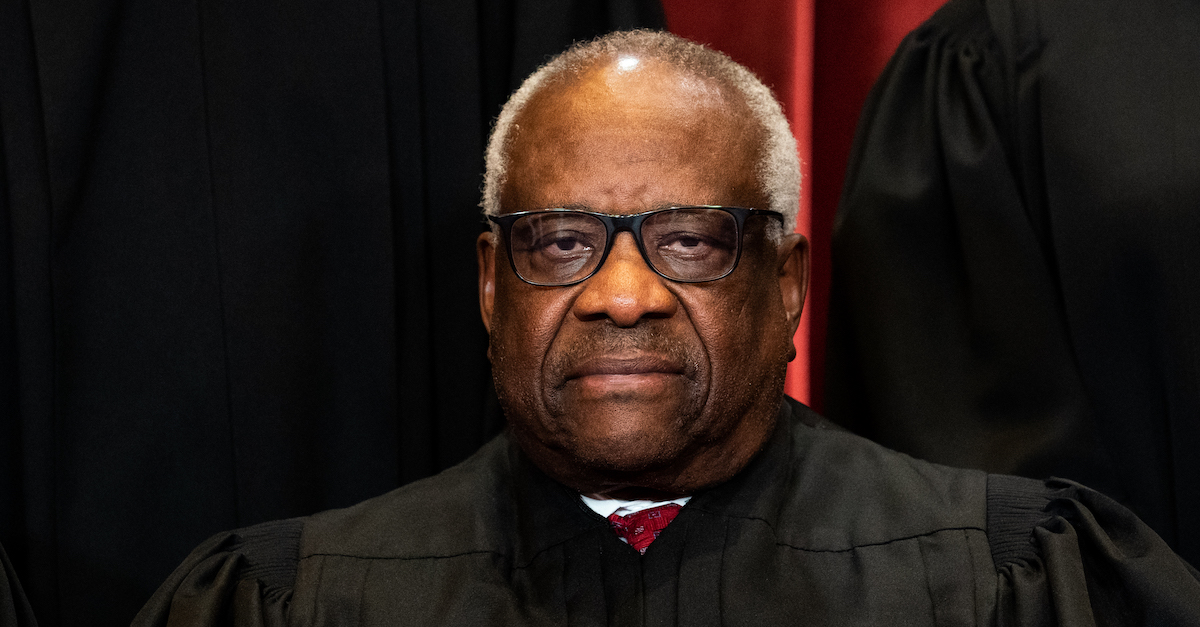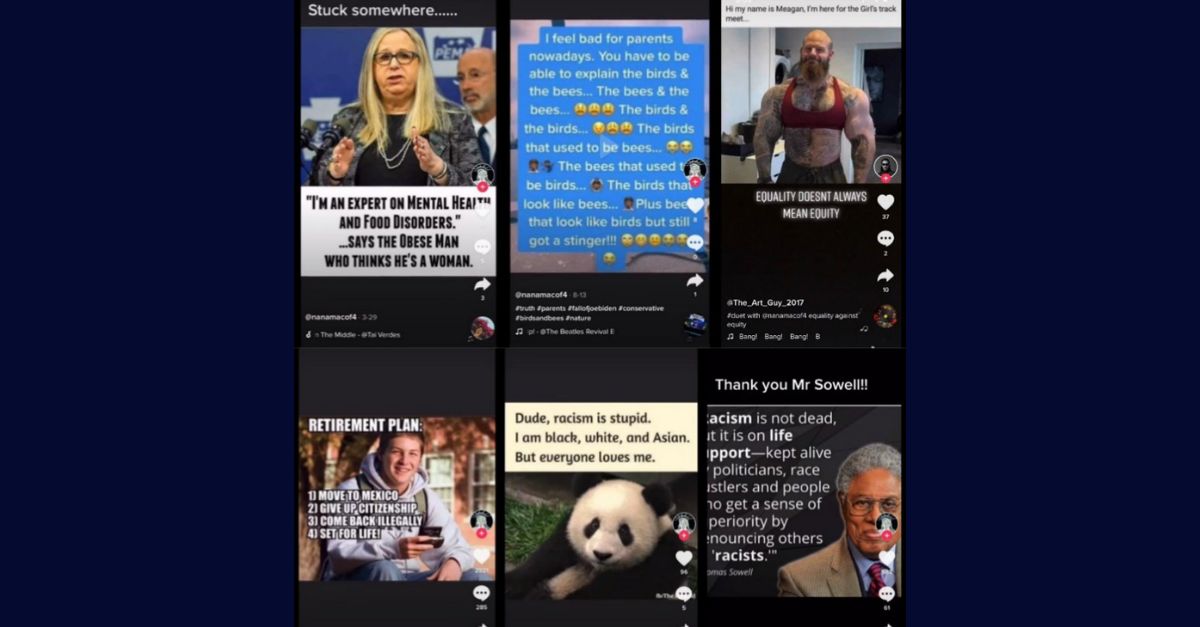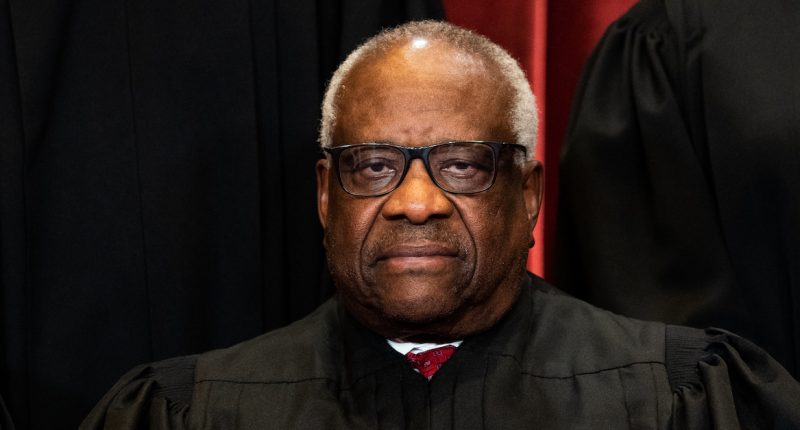
Associate Justice Clarence Thomas sits during a group photo of the Justices at the Supreme Court in Washington, D.C on April 23, 2021. (Photo by Erin Schaff/Pool/Getty Images.)
After a blockbuster week of opinions, the U.S. Supreme Court on Monday refused to take up the cause of a public school teacher who was fired after the revelation of TikTok memes she liked or shared prior to her employment. But one justice had much to say about the denial, even if he ultimately agreed not to grant the case.
The rejected petition for a writ of certiorari from September noted that Kari MacRae was a public school math and business teacher in Massachusetts who was fired over “hot-button political speech she had posted on social media before she was hired by” Hanover Public Schools.
Those memes, in the words of Justice Clarence Thomas, expressed MacRae”s views “that immigration laws should be enforced, that an individual’s sex is immutable, and that society should be racially color-blind.”
One, for example, showed an image of Joe Biden’s Assistant Secretary for Health Dr. Rachel Levine — the first openly transgender official to be confirmed by the U.S. Senate — accompanied by these words: “‘I’m an expert on mental health and food disorders.’ … says the obese man who thinks he’s a woman.”
Love true crime? Sign up for our newsletter, The Law&Crime Docket, to get the latest real-life crime stories delivered right to your inbox
Another post showed a panda bear and included the caption, “Dude, racism is stupid. I’m black, white, and Asian. But everyone loves me.”
A third used the clueless college freshman meme template and stated: “Retirement plan: 1) move to Mexico 2) give up citizenship 3) come back illegally 4) set for life!”

Six TikTok posts that Kari MacRae cited as an exhibit in her Supreme Court petition.
For Thomas, MacRae’s case was appropriately denied because her petition did not “squarely challenge” the First U.S. Circuit Court of Appeals’ “application” of the Supreme Court’s “framework for public-employee speech,” known as the Pickering-Garcetti balancing test, which emerged from a series of Supreme Court decisions dating back to 1968. One of those cases concerned the rights of public school teacher to comment on “matters of public concern” as a citizen compared to the state’s interest in avoiding disruption in the classroom.
The Garcetti portion of the framework stems from Garcetti v. Ceballos, a 2006 SCOTUS case that held as follows: “When public employees make statements pursuant to their official duties, they are not speaking as citizens for First Amendment purposes, and the Constitution does not insulate their communications from employer discipline.”
Thomas said that even though he agreed with the rejection of MacRae’s case, he wrote to “raise serious concerns about the First Circuit’s approach,” which he called “deeply flawed” and something worth revisiting should the right case come to SCOTUS’ doorstep. In Thomas’ view, the lower courts credited “purely speculative” predictions of disruption to tip the balance toward the school district and against MacRae [some citations removed]:
This case turns on the balancing component of the Pickering-Garcetti framework. All agree that MacRae’s TikTok posts qualify as speech on matters of public concern, but the First Circuit concluded that the balance of interests favored respondents. That court first discounted the value of MacRae’s speech interest because her posts, which are reproduced below, at times spoke in what the court described as a “mocking, derogatory, and disparaging manner.”
In contrast, the First Circuit explained that respondents — who fired MacRae out of “concer[n] about the potential negative impact [her] social media posts would have on staff and students” — had a “‘strong'” interest in avoiding disruption, and that they made a “reasonable prediction of disruption.” The court pointed to factors such as the public attention and news coverage MacRae had received in light of her position on a neighboring town’s school board, as well as the fact that at least some Hanover students and staff were aware of her posts. It also cited the fact that “some of her TikTok posts (at least arguably) conflicted with the District’s belief of ‘[e]nsur[ing] a safe learning environment based on respectful relationships’ and Core Value of ‘[r]espect[ing] . . . human differences,'” “given the potential to perceive some of her posts as transphobic, homophobic, or racist.” The First Circuit concluded that, on balance, the risk of disruption outweighed MacRae’s interest.
But worse than that, Thomas wrote, the 1st Circuit “compounded its reliance on speculative factors with consideration of illicit ones.”
“We have made clear that the core First Amendment principle of viewpoint neutrality applies in the Pickering-Garcetti context as elsewhere,” Thomas said, before adding a couple of lines later: “It undermines core First Amendment values to allow a government employer to adopt an institutional viewpoint on the issues of the day and then, when faced with a dissenting employee, portray this disagreement as evidence of disruption. And, the problem is exacerbated in the case of an employee such as MacRae, who expressed her views only outside the workplace and before her employment.”
Thomas concluded that MacRae’s free speech interest was “improperly discounted” and that this is a part of a “trend” in lower courts getting SCOTUS’ First Amendment precedent wrong in “controversial political speech” cases.
The conservative justice encouraged the court to put a stop to this trend in the future.
“In an appropriate case, I would make clear that public employers cannot use Pickering-Garcetti balancing generally or unsupported claims of disruption in particular to target employees who express disfavored political views,” Thomas wrote.








